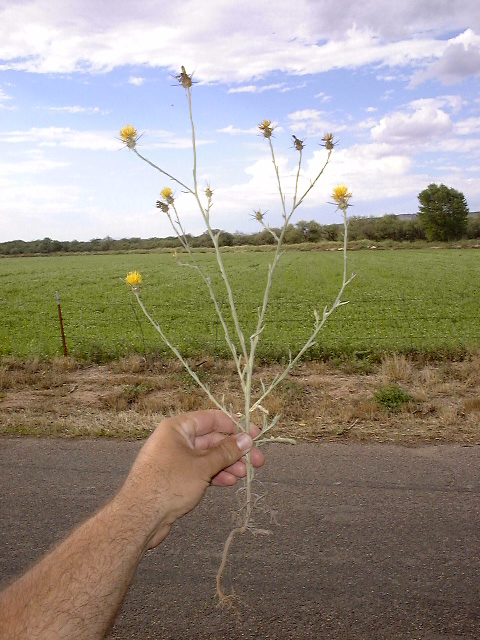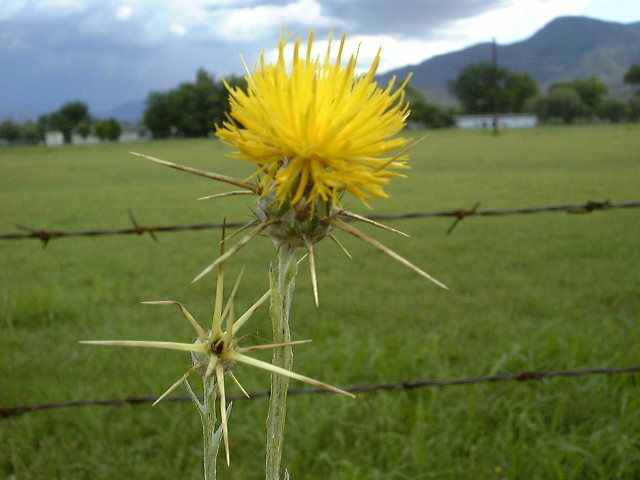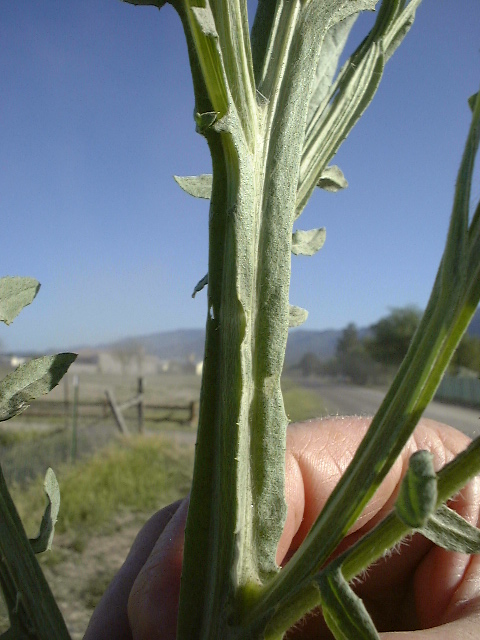 Yellow Starthistle: a Serious Local Issue - March 21, 2012 Jeff Schalau, Agent, Agriculture & Natural Resources University of Arizona Cooperative Extension, Yavapai County A noxious weed is a plant specified by law or regulation to be particularly undesirable, destructive, and/or difficult to control. Yellow starthistle (Centaurea solstitialis) is a noxious weed that can be found in areas on the southern end of Camp Verde. Recently, the Camp Verde Town Council has recognized the seriousness of the problem and is mounting an effort to educate citizens about this weed and work with other local entities to manage the existing population and reduce its spread. Yellow starthistle is native to the Mediterranean region of Europe. It is thought that it arrived in North America in alfalfa seeds shipped to California during the mid-1800's. Today it can be found in 23 of the contiguous 48 states. It now covers over 14 million acres in California and is increasing rapidly in Idaho, Oregon, and Washington. In the west, yellow starthistle poses the most serious threat to semiarid rangelands but also can infest orchards, roadsides, ditch banks, and open space. Aside from being invasive, yellow starthistle is poisonous to horses and causes “chewing disease”: a fatal neurological disorder. Yellow starthistle is a cool season annual with bright yellow flowers. The flowers occur singly on the ends of short branches and are armed with stout, straw-colored spines 1 to 1 ˝ inches long (see photos below). In the spring, the plant consists of a rosette that lies close to the ground. In early summer, the stems elongate to produce a plant that ranges from 4 inches to 5 feet tall. Later in the growing season, flowers fade to a dull straw color. It produces abundant seed. Some of the seeds are plumed and disperse quickly. The plumeless seeds persist in the dead flowers until the plant is disturbed. Seeds are spread to new areas by wind, in the fur and feathers of animals and birds, by animals and birds eating seeds and passing them through their gut, and by human activity. Seeds are often transported to uninfested areas by livestock, vehicles, tractors, heavy equipment, shoes, in loads of hay, by flowing water, and other means. Approximately 95% of the seeds are viable and 10% of the seed can remain dormant for up to 10 years. Management of yellow starthistle requires an integrated weed management approach that detects and contains existing populations while reducing plant density and hence the numbers of seeds lying dormant in the soil. An integrated approach should utilize several strategies: prevention, mechanical control, herbicides, grazing, and biological control using introduced insects. Revegetation with desirable plants, usually cool season grasses, competes with yellow starthistle for growing space. Prevention strategies include cleaning of equipment and vehicles after use in infested areas and monitoring. Mechanical control strategies include hand pulling and tillage before flowering. Herbicides are an important management tool and new formulations are very effective on yellow starthistle. Grazing strategies utilize cattle, goats, or sheep to remove starthistle before it flowers and give desirable plants a competitive advantage. Grazing should be carefully timed to remove plants as they bolt out of the rosette stage and prior to the spiny flower stage. Biological control is one of the most important practices in an effective noxious weed management program. There are several insects that have been imported from yellow starthistle’s native range. To date, three weevils and three flies have been approved for use on yellow starthistle by the USDA APHIS. These insects attack the flowers and reduce number of viable seeds. Biological control will never provide 100% control, but can have a great impact when combined with one or more of the strategies outlined above. The Town of Camp Verde, University of Arizona Cooperative Extension, Verde Natural Resource Conservation District (NRCD), Verde River Greenway, and USDA Forest Service are planning an educational session this spring to fight the spread of yellow starthistle. I will also be giving a presentation on identification and management of noxious weeds at the Keep Sedona Beautiful (KSB) Native Plant Workshop on March 24. Brad Lancaster and Jan Busco will provide keynote presentations on rainwater harvesting and using natives, respectively, along with several other notable presenters. The workshop will be held on March 24, 2012 at 8:30 am at the West Sedona School, 570 Posse Ground Rd in Sedona. Go to www.keepsedonabeautiful.org or call 928-282-4938 for more information. Follow the Backyard Gardener on Twitter – use the link on the BYG website. If you have other gardening questions, call the Master Gardener help line in the Camp Verde office at 928-554-8999 Ext. 3 or e-mail us at cottonwoodmg@yahoo.com and be sure to include your name, address and phone number. Find past Backyard Gardener columns or provide feedback at the Backyard Gardener web site: http://cals.arizona.edu/yavapai/anr/hort/byg/. Photos  Yellow Starthistle - Entire Plant  Yellow Starthistle Flower  Yellow Starthisle Stem > |